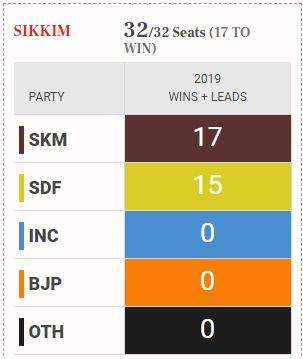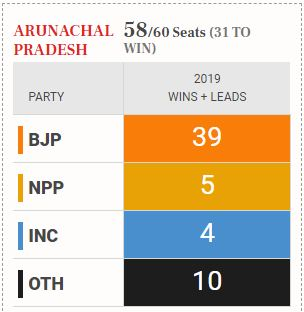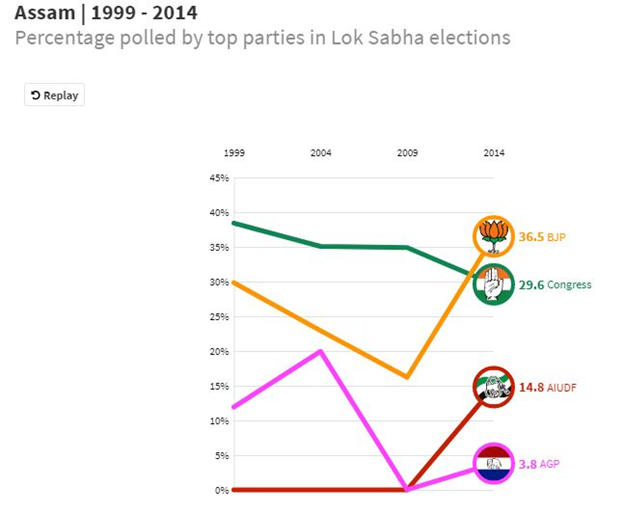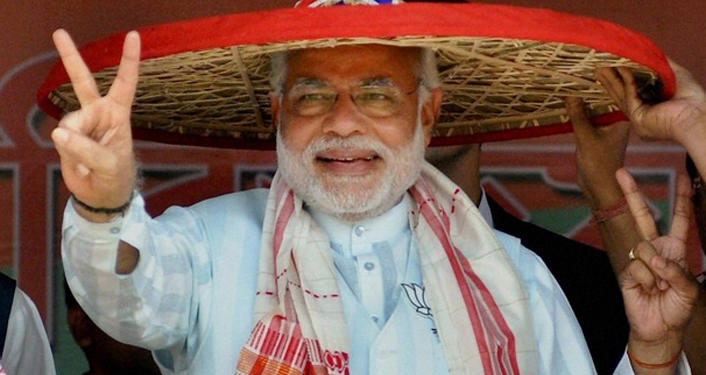Exactly three years back on May 24, 2016, BJP along with regional political parties like Naga People’s Front (NPF), Sikkim Democratic Front, and People’s Party of Arunachal, Asom Gana Parishad and Bodoland People’s Front (BPF) had formed North-East Democratic Alliance or NEDA. The motive of the new political front is to unite non-Congress parties in Northeast India, with Assam BJP leader Himanta Biswa Sarma as the convener of the front. The efforts by the party reaped political dividends as it won 14 seats out of 25 and its NEDA allies also performed very well.
Since PM Modi and Amit Shah took over the leadership of BJP, the party has been able to make major inroads in Northeastern states. The party repeated spectacular performance of 2014 in 2019. In fact, it improved the tally from 8 to 14 while Congress was reduced to 4 seats from 8 in the previous general election. In Assam (14 seats), the largest state in the region, the number of seats won by reached to 9 compared to 7 in previous general election. Congress and AIUDF won 3 seats each in the previous election but in 2019, Congress has been able to defend its tally but AIUDF suffered a loss of two seats. The tally of independent remained at one in the state.

In Arunachal Pradesh, Pema Khandu led BJP won both Lok Sabha seats of the state as well as the assembly elections. In the assembly elections, the party won 39 out of 60 seats and will be able to form majority government very easily. Another state which was having state and Lok Sabha elections simultaneously was Sikkim where Sikkim Krantikari Morcha (SKM) won the parliamentary (1 seat) as well as assembly elections. SKM won 17 seats out 32 while the incumbent Sikkim Democratic Front won 15 seats.


The people of Tripura seems happy with the performance of the state government and elected the party on both seats. Despite all the mockery of Biplab Deb by the left-liberal establishment, he toppled popular state chief minister Manik Sarkar who ruled the state for more than two decades and delivered the Lok Sabha seats too. In 3M States (Manipur, Meghalaya, and Mizoram) and Nagaland, the regional parties which are part of BJP’s Northeastern Democratic Alliance (NEDA) held the fort. In Manipur, BJP won one seat while the other seat was one of Naga People’s Front. In Meghalaya, Congress won one seat while the other was won by BJP ally National People’s Party (NPP). In Mizoram and Nagaland, Mizoram National Front (MNF) and Nationalist Democratic Progressive Party (NDPP) won the seats.

In the last five years, Modi government made tremendous efforts to improve the condition in the Northeast. The Modi government has opened two bridges on Brahmaputra river in four years of its rule. The new Saraighat Bridge, built along the old rail-cum-road bridge was inaugurated by Transport minister Nitin Gadkari in 2017. Another major bridge opened by Modi government in the previous year is Dhola Sadiya Bridge (also known as Bhupen Hazarika Bridge) which connects the state of Assam to Arunachal Pradesh. The strategically located bridge is very important from the security point of view in the wake of Chinese aggression in Arunachal Pradesh.
The strengthening of infrastructure in the Northeast is very important for security purpose as well as for the benefit of the local population. When India fought the 1962 Indo-China war, we had no existing infrastructure for easy movement of armed forces. Even after losing the war, successive governments made very little efforts to develop the region due to heavy cost and difficulties in it. The skirmishes on the Indo-China border in the northeastern border were regular events but the governments did not wake up. China had announced a plan to build a massive dam on a tributary of Yarlung Zangbo (Tibetan name of Brahmaputra River) and it will be the most expensive hydel project in the world. China plans to assert its claim over Arunachal Pradesh by building a dam over Brahmaputra’s tributary.
India could give a befitting reply to China only if it has a solid infrastructure in the region for movement of its armed forces to fight the mighty Chinese forces. The infrastructure development in the region is also important from the civilian point of view, as it will make the life of people in the regions a bit easier. The people in the Northeastern region live in a very difficult condition, therefore, investment by government is necessary. The infrastructure development in the region will also promote tourism in the region which will bring economic prosperity of people living in Northeastern states. The Modi government is very much committed towards development of Northeast. The Ministry of Development of North Eastern Region (DoNER) is there to look after the implementation of projects aimed towards the Northeastern region. The previous governments feared from developing infrastructure in the Northeast due to massive difficulties faced at the Brahmaputra riverfront but Modi government has opened three bridges and planned five more. Brahmaputra river is no longer a hindrance in the development of Northeast India.


































